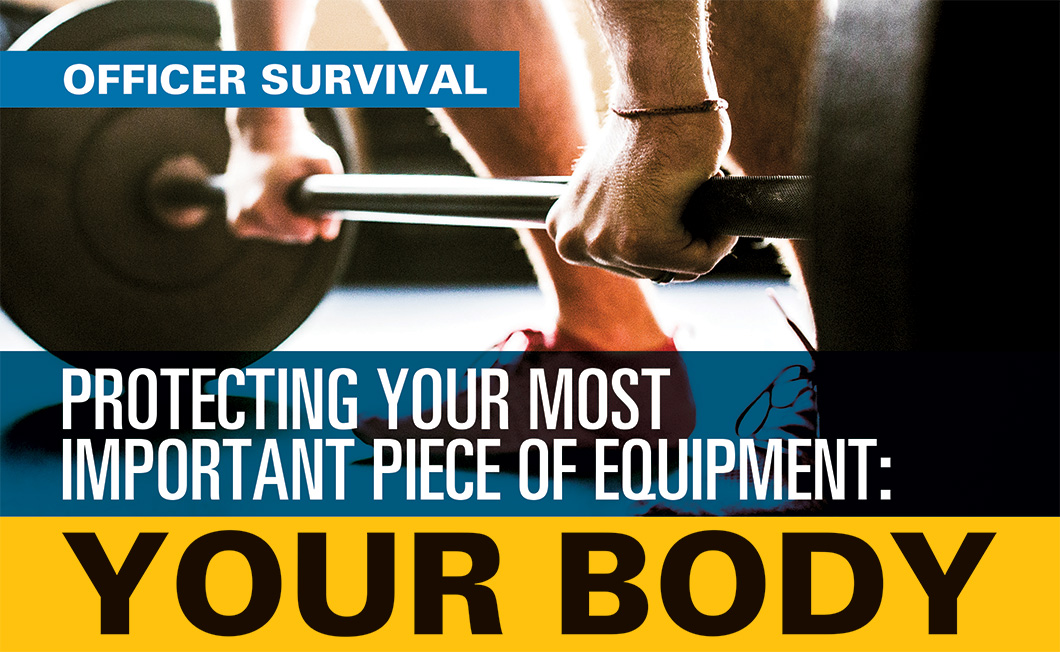
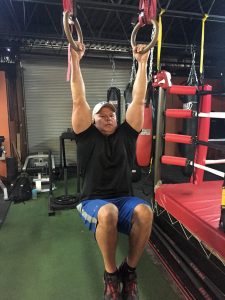
The main focus of your training should be functional strength and movement. It should be specifically designed to enhance your ability to physically perform in the field, including such activities as climbing, jumping, running and fighting.
By Darren Norris
Photos courtesy of Darren Norris
Always consult with a physician before beginning any exercise program. This general information is not intended to diagnose any medical condition or to substitute for your health care professional. Consult a health care professional to design an appropriate exercise prescription. If difficulty or pain is experienced with physical activity, stop and consult a health care provider.
The law enforcement profession is becoming increasingly hazardous on numerous fronts. Officers are seemingly under fire both figuratively and literally. Combine the dangers associated with working in law enforcement with arduous working schedules due to manpower shortages or the necessity to work off duty, poor nutrition, lack of exercise, little to no sleep, and the various internal and external stressors from work and personal life, and you have a perfect storm that will devastate anyone’s health and well-being. One of the most dangerous threats is the one that many officers face in the mirror every day — themselves! The bottom line is, people can be extremely self-destructive through their actions and inactions when it comes to wellness. Regardless if it is work-related stress or other personal issues, many officers will attempt to blame the poor eating habits, and lack of exercise and training on any of the usual excuses.
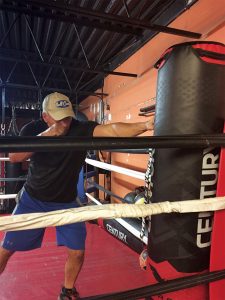
Oftentimes people have difficulty beginning an exercise program. There are numerous reasons for this, but some of the usual suspects are uncertainty on what to do, when to do it or how to even start. The answer is simple: Don’t sit for days or weeks planning out an intricate workout program. All a person has to do is start moving! Don’t wait: Do it now! It is literally that simple! It does, however, require a level of self-discipline to begin, work toward and achieve the first short-term goal. An exercise program can start with very basic content, such as stretching, walking and pushups. One can later progress into more advanced workouts that have been properly planned to achieve specific goals. A typical workout program should include exercises that are designed to improve flexibility, aerobic endurance, and static and dynamic strength for anaerobic performance. There are numerous variants to most exercises, as there are numerous training philosophies regarding what type of exercise program works best. In recent years, many have migrated toward functional fitness programs that focus on training in line with athletic programs. After all, aren’t police officers supposed to be physically fit and perform basic athletic functions during the course of their duties?
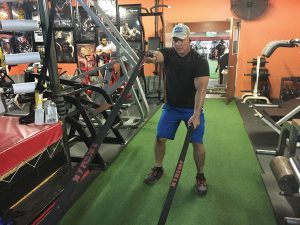
When assessing individual functional fitness levels, one must first determine exactly what is being referred to. Simply defined, functional fitness is physical fitness training that is specifically designed to provide officers with task-specific dynamic flexibility, agility and strength needed to perform the duties that law enforcement officers are tasked with daily. Being properly conditioned for dynamic confrontations will significantly reduce the chances of becoming injured and greatly increase the chances of officer survival during a violent confrontation! Proper conditioning also increases confidence, performance and improved cognitive processes, the latter being one of the most valuable tools in police work. As a rule, law enforcement officers have limited time to spend in the gym working out to achieve their fitness goals due to working overtime, off-duty details, family commitments, etc. Some people have no interest in working out because they may be naturally lean and don’t feel the need, whereas others are just lazy and would rather spend their time in the recliner or surfing the internet.
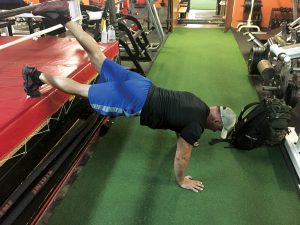 Try this self-assessment exercise: Set a timer for three minutes and go to work punching on a heavy bag. This simple test will gauge the cardiovascular conditioning level. After this simple exercise, an officer can then honestly decide what kind of shape they are really in. Officers never know what kind of confrontation awaits around the next corner. This is why it is imperative to keep our mind, body and tactical skills honed. Officers must constantly challenge themselves and their training on a daily basis in order to maintain a superior level of fitness and operational skills. Simply stated, officers must train in a manner that will significantly help achieve goals of being faster, more agile and stronger than the bad guy.
Try this self-assessment exercise: Set a timer for three minutes and go to work punching on a heavy bag. This simple test will gauge the cardiovascular conditioning level. After this simple exercise, an officer can then honestly decide what kind of shape they are really in. Officers never know what kind of confrontation awaits around the next corner. This is why it is imperative to keep our mind, body and tactical skills honed. Officers must constantly challenge themselves and their training on a daily basis in order to maintain a superior level of fitness and operational skills. Simply stated, officers must train in a manner that will significantly help achieve goals of being faster, more agile and stronger than the bad guy.
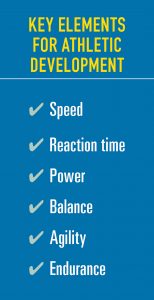
Law enforcement requires personnel to train and perform as athletes, in that they have a specific goal in mind while working within agency policy guidelines. How do athletes train? They take into account the facets that make up an athlete: speed, reaction time, power, balance, agility and endurance. The main focus of the training is functional strength and movement training. What good is it to bench press 400 pounds if after sitting down for three hours an officer cannot spring out of a squad car, perform a 60-yard sprint chase hurdling various obstacles and, quite possibly, engage in a fight for their life while toting an extra 20 pounds of gear?
With specific training comes specific equipment needs. Officers need to get down to the essence of athleticism and train the body as a whole, not parts! Isolation of muscles in strength training, unless for specific injury prevention or rehabilitation, is useless in the field. Some of the equipment that should be used are medicine balls, agility ladders, hurdles and plyometric boxes (both vertical and lateral).

My Own Journey Back to Health
Over the last few years, I fell victim to my own reckless behavior. Daily I was consuming six to 10 Mountain Dews and Monster Energy drinks, and loading my plate with every type of junk food imaginable. I stopped going to the gym and adopted a sedentary lifestyle. My weight skyrocketed to 356 pounds. On March 15, 2016, I was diagnosed with diabetes, with an A1C of 8.3. I called my close friend and former SWAT teammate, who is a physician, and advised him of the diagnosis my doctor gave me. In a nutshell, he told me I was fat and being lazy. Further, he told me to lose weight to improve my A1C. I made the decision right then to make a positive change in my life. I immediately got back in the gym and adjusted my diet. Make no mistake, I got back in the gym with purpose and got to work! I went back to my doctor 90 days later and had my A1C checked again. It was down from 8.3 to 5.9 with no medication. Today it is 5.2, and I no longer take medication for acid reflux or hypertension. My weight is down from 356 to 260. I am sharing my story in the hope that it will motivate readers to take action now to live a healthier lifestyle. Remember, we only get one shot at life, so don’t waste it!
Take into consideration that the hands are the terminating body part. They do all of the manipulation, controlling, climbing and shooting. Use exercises such as throwing medicine balls overhead, behind the back, from the chest, from each side and just about every way to apply force to the ball. Remember, danger does not always come head-on!
Agility ladders are a more recent invention, originally used in track-and-field settings to increase foot quickness and regulate stride length. One- and two-leg hops, lateral jumps, and quick feet and rhythm drills are great ways to build speed and agility. Picture an officer having to run across a creek and jump from rock to rock, placing each foot precisely but quickly, while balancing their body in the air as well as on the ground. This is where these types of exercises may apply in the line of duty.
Plyometric or “plyo” boxes are another training modality. Boxes are usually of steel and wood construction, with a rubber, nonslip top. They range in size from 6 to 42 inches in height. Many exercises can be performed on these boxes, such as jumps onto and off of them, using one leg or two. That is purely plyometric — the absorption and redirection of force using momentary stored energy of the muscles and tendons. We use not only vertical box drills, but lateral ones as well, with the movement being side to side and pushing off of an angled surface.
Lastly in the functional conditioning phase of the training, we develop cardiovascular fitness. Officers must be able to pour on the juice at max effort, walk it off or possibly be still for a few minutes, and be able to repeat it all day long if needed. That is where we enter the world of “applied cardio.” When the correct amount of time under tension (duration of activity under load) is coupled with predetermined rest periods, the target heart rate can be sustained for long periods of time while working muscles anaerobically (explosively). This is a form of interval training used with many athletes.
There are countless methods for conducting physical training as well as several variations to any exercise program. No matter what type of physical training you participate in, either individually or as a team, it should be specifically designed to focus on the challenges that you encounter as a law enforcement officer. These challenges may include things such as climbing, jumping, running and fighting. Therefore, the drills can include boxing, obstacle courses, fence climbs, etc.
Proper nutrition combined with adequate exercise are the two key components to building a foundation for a healthy lifestyle. Anyone can implement and execute a physical training program with the intent of dropping weight, improving performance and, ultimately, improving health all the way around. However, a proper diet needs to be a part of the daily regime in order to gain the most benefit from the fitness program. The positive physiological impact that eating clean has on the body is limitless. Many law enforcement officers consume an insane amount of processed, carb-heavy and fatty meals as the norm. Thus, many officers are overweight and have chronic health issues. Improper nutrition will eventually lead to a host of health-related issues such as heart disease, diabetes, acid reflux, sleep apnea, hypertension and cancer. Now for the positive! The positive changes that the human body experiences from eating clean are exponential.
Eating the right foods will create positive physiological changes such as increased energy, lower risk of heart disease, decreased risk of diabetes and improved brain function, to name only a few. So, what is clean eating? Clean eating is nothing more than adhering to a balanced diet that includes protein, whole grains, healthy fats, and fruits and vegetables. An average diet plan should range from 1,200 to 1,800 calories. There are several calculators available online for accurately computing the required caloric intake needed to sustain and achieve the desired goals. Don’t think of clean eating as a diet or a chore. A conscious decision for making a lifestyle change will be much easier to stay committed to than failed attempts at fad diets. At least two hours a week should be dedicated to meal preparation. Having a solid meal plan and putting in the preparation time will aid in sticking to a clean eating routine. When it is time to put the meal plan into action, officers should try to eat small, balanced portions every 2 1/2 to three hours. Keeping the body properly fueled will help boost and stabilize the metabolism, which in turn will help a person reach their desired goals and assist in maintaining a healthy lifestyle. For more nutrition tips, including a sample menu plan and comprehensive printable grocery list, check out “Food Prep Made Efficient and Easy.”
Sometimes officers reach a certain level of experience in their careers and feel that they do not need to train as hard because they can handle anything that they are confronted with, like they have on previous occasions. This is the “I am special” mindset. This type of mentality can prove fatal to the officer, fellow officers and other innocent parties. So be prepared for every situation by training hard, staying fit and eating well!
Darren Norris retired as the assistant chief of police with the Pelion Police Department and was appointed as an associate municipal court judge in South Carolina in October 2017. He is the chief operations officer with MUR Strategic, a company that specializes in military and law enforcement training and protective security operations. He has over 28 combined years of military and law enforcement experience. A state-accredited law enforcement instructor since 1995, he has served in command, patrol, K-9, SWAT and investigations assignments throughout his career and is an active member of Midlands Lodge #1.
Read this story in the Winter 2017 issue of FOP Journal.




